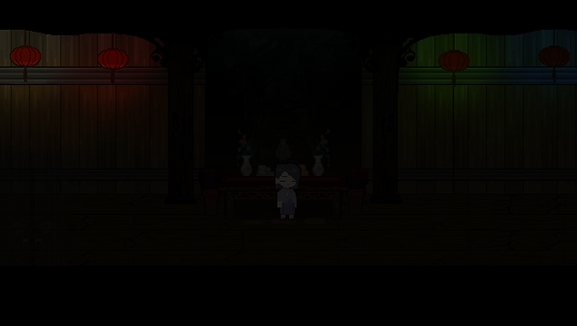
GAME INFO
"Zhou" is a 2D narrative-driven horror game set in the backdrop of Chinese folklore.
Zhang Wangshu has no memories before age seven. Raised in an orphanage, she has long been haunted by recurring dreams of a forgotten village—its winding paths, ancient rituals, and something waiting in the dark. Drawn by this unshakable vision, she becomes a folklorist and a columnist specializing in vanishing cultures.
One day, her editor receives an unusual letter: an invitation from a remote place called Zhou Village, requesting a researcher to document their traditions. The assignment lands in Wangshu’s hands.
And so begins the prologue—where memory, myth, and something far older converge.
MY ROLE
I'm the lead designer of this project, and therefore have the responsibility to decide the overall game direction and narrative. Since our game group has only four people, and I'm the only designer (my teammates include two artists and one programmer), I took on the overall project management role to ensure we could produce a relatively complete game within the limited time and workforce.
The central focus of this project is to create a prologue that features a closed plotline while leaving room for future development. Meanwhile, I strived to make sure the gameplay and narrative work together to create space for exploration and meaningful interaction.
CASE STUDY & NARRATIVE DESIGN
GAMEPLAY
Backpack system
In the game, player could collect certain objects and store them in their backpack. Interacting with objects within the backpack could reveal a specific description.
I integrated the tutorial for backpack system into the opening scene of the game: player could follow the plotline through dialogue and their interaction with the backpack to progress. I was able to set up the background story, new objectives, and tutorial at the same time through this design.
Interactive objects
I want players to interact with objects not only by collecting and reading from them; therefore, I discussed with our group's programmer and reached agreement on adding different mini interactions (etc., mouse drag to light up candle with match). The design of every mini-interaction goes along with main puzzles with the scene in adjust with pacing and storytelling.
LEVEL DESIGN
Sections & Map
There are two sections in the entire game process. The first section was designed as three linear scenes that work with tutorials to get the player familiar with basic control and gameplay. Most puzzles and explorations happen in the second section, the village's main house (map on the right).
Map design was done to match up with how the actual reference house looks while matching the needs of puzzles. The plotline design works along with the map to ensure players get to use all rooms in different time spans of the game.
Cross-room puzzle
When player escape from a threatening scene at some point in the game, they'll discover that the front door towards the outside is locked and their communication device has gone missing. This cross-room puzzle was designed to release tension for the upcoming climax( the chasing scene) while balancing between narration and interaction.
Through interacting with the offering table, players will witness a series of lanterns with different colored light up in a sequence. Those colors match up with the mask in the mask room. After interacting with the statue, the player will be able to drag the mask to change their sequence.
Hints will be given to players at the mask room when they finish interacting with the offering table in the ritual room.
Player need to explore both rooms and find a way to come up with a solution to the puzzle in their mind. All information needed to solve the puzzle was in one room while the actual interaction of puzzle solving was in the other.
Puzzle in chase scene
The chasing scene contains the fastest-paced interaction while also requiring players to think calmly and stand up to the pressure.
Players were trapped in a series of similar rooms and had to react within several seconds to determine where they should head. The only difference between rooms is the direction of bleeding eyes on the wall. That door led to the killer, and where they all died.
On the narrative side, this puzzle was designed to finally drag the evilness of the village to the surface. Also, as the transitional scene to ending, it sets up the tone and hints at the character's fate.



the ritual room

the mask room





